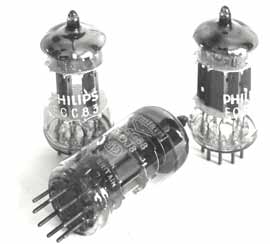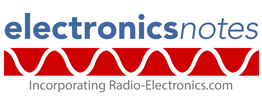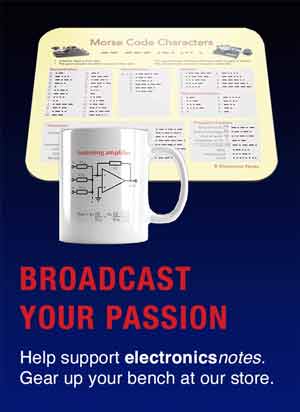Triode Valve / Vacuum Tube: operation, theory, formulas
The triode valve or triode vacuum tube can be used in a variety of different electronic circuit designs as an amplifier, rectifier or to provide a variety of other functions.
Vacuum Tube / Thermionic Valves Includes:
Basics
How does a tube work
Vacuum tube electrodes
Diode valve / tube
Triode
Tetrode
Beam Tetrode
Pentode
Equivalents
Pin connections
Numbering systems
Valve sockets / bases
Travelling wave tube
Thermionic valve or vacuum tube technology came into its own when it was discovered that the triode valve could be used to amplify electronic signals.
As the name indicates, the triode valve or triode vacuum tube uses three electrodes, the cathode and anode as in the diode and a third electrode called a grid placed between the anode and the cathode.
The addition of the third electrode in the triode vacuum tube opens up its operation making it a considerably more functional device.

Triode valve basics
The triode valve or triode vacuum tube takes the basic concept of the diode and moves it on a significant stage further. A third electrode called a grid or more correctly a control grid is placed between the cathode and anode of the basic diode and by applying a potential to the grid, it is possible to repel or attract the electrons being emitted from the cathode and in this way affect the flow between cathode and anode of the triode vacuum tube.

When there is no voltage on the grid of the triode valve or triode vacuum tube, the current between the cathode and anode will be at its maximum. Placing a negative voltage onto the grid will have the effect of repelling some electrons back to the cathode and thereby reducing the number of electrons travelling to the anode.
Varying the negative bias on the grid will modulate the current flowing towards the anode.
When a triode valve is used within in a circuit, a resistor is placed in the anode circuit. The modulated audio current between anode and cathode will appear across this resistor as a large amplified replica signal, but 180° out of phase with the input.
Triode control grid
The control grid typically consists of a helical wire that is placed between the cathode and the anode. In some instances a mesh may be used. The actual construction and ‘density’ of the control grid being dependent upon the performance and characteristics that are required from the triode vacuum tube.
The control grid in the triode valve or triode tube serves as an imperfect electrostatic shield allowing some, but not all of the electrostatic flux from the anode to leak through to the cathode.
The triode valve / tube will normally operate under space charge limited conditions. Under these circumstances the number of electrons that reach the anode, i.e. the anode current, is almost solely determined by the electrostatic field in the cathode grid space.
Once the electrons pass through the grid, they travel so rapidly towards anode that any space charge effects in the grid anode region can be virtually neglected.
In this way the negative voltage on the grid acts as a controlling voltage that controls the amount of current that flows in the anode circuit.
Typical triode valve / tube circuit
The circuit of a very simple valve or tube amplifier using a triode is shown below.

In this circuit, the resistor R3 serves to keep the grid at ground potential. Typical values for this may be around 100kΩ. The resistor, R2 in the cathode will develop a voltage across it as a result of the current flowing in the cathode - anode circuit. As the grid is at ground potential, the voltage across R2 will be the amount by which the grid is negative with respect to the cathode.
The resistor in the anode circuit, R1 develops a varying voltage across it as the current through the triode valve varies.
Capacitor C1 provides coupling on the input and the capacitor C2 provides coupling for the AC signal on the output, blocking the DC which is likely to be high.
The capacitor C3 acts as an AC bypass capacitor across the cathode resistor R2. This increases the AC gain of the circuit whilst retaining he required DC bias conditions.
Triode valve design aspects
When designing, repairing, or servicing triode valve / triode vacuum tube circuits it is very useful to have an understanding of the theory and what the different performance specifications mean.
The voltage and current relations in the triode for both anode and grid are of importance along with figures like triode amplification factor, the anode or plate resistance and the transconductance.
All of these give an understanding of the performance of a particular triode valve or triode vacuum tube.
Triode voltage & current relations
One of the important relationships in a triode valve is the link between the voltage and current on the device.
The number of electrons that reach the anode of a triode valve or vacuum tube under space charge limited conditions is primarily governed by the electrostatic field in the cathode grid region.
Once the electrons have passed through the grid they travel on towards the anode very rapidly and space charge effects can normally be ignored, especially to a first approximation which is normally good enough for most calculations.
The critical area of the triode valve is within the cathode grid space. It is here that the theory needs to be examined to determine its operation.
In the cathode – grid area the electrostatic field is determined by both the grid and anode or plate.
Electrostatic shielding theory shows that the electrostatic field in the vicinity of the cathode of a triode is proportional to (Ec + Eb/µ), where Ec and Eb are the grid and anode voltages respectively. The voltages are measured with respect to the cathode. µ is the amplification factor of the valve.
Triode amplification factor µ
The value µ is the constant known as the amplification factor of the valve or vacuum tube – it applies to triodes and is not really applicable to tetrodes or pentodes. It is independent of the voltages on the grid and anode and is determined by the geometries of the elements within the valve. Typically of the grid is placed close to the cathode this will give it a high amplification factor. For most triodes the amplification factor falls within the region of 10 to 100.
The amplification factor µ of a triode valve / vacuum tube is a measure of the relative effectiveness of the grid and anode voltages in producing the electrostatic fields at the surface of the cathode.
In more practical terms the amplification factor, µ of a triode can be considered to be the theoretical maximum gain that can be obtained. The amplification factor is based on the variation of anode voltage to grid voltage, but it is measured with the anode current held constant.
Where:
µ = amplification factor
ΔVa = change in anode voltage
ΔVg = change in grid voltage
Triode characteristic curves
The performance and characteristics of triode valves or vacuum tubes are often represented by a number of graphs detailing their performance.
The characteristic curves or graphs are normally plotted for the relationship of the grid voltage and anode or plate current, and for the relationship of the anode or plate voltage and the corresponding current.

The various curves of grid voltage against anode current all have approximately the same shape, differing mainly in the displacement from each other. This results from the fact that the anode current is determined by the equation (Ec + Eb/µ).

In a similar way that the curves for the grid voltage and anode current are similar, so too are those for anode voltage and current, although it can be seen that the curves for positive grid voltage are rather different.
Anode resistance
The anode resistance or plate resistance is more exactly described as the dynamic anode or plate resistance. It represents the resistance that the anode circuit offers to a small change in voltage.
Therefore when a small increment in anode voltage ΔEb produces a small change in anode current ΔIb the anode resistance can be calculated as follows:
Where:
rp = dynamic anode resistance
Triode mutual conductance or transconductance
The transconductance or mutual conductance gm of a triode is defined as the rate of change of anode current with respect to the grid voltage.
It is possible to express this as a simple equation:
Where:
µ = mutual conductance / transconductance
rp; = anode resistance
The transconductance or mutual conductance is a form of conductance, i.e. the inverse of Ohms. As a result the units in which they were quoted where mhos (Ohm spelt backwards). Nowadays the unit of conductance is the Siemens (S), but for valves / tubes the unit mho is still used.
For valves the figures were normally quoted in µmhos, so be aware as this would make gain figures enormous if the µ was missed.
In very much later calculations associated with valves, gain figures started to be given in terms of mA/ V, where the voltage (V) was applied to the grid, and the current (mA) was the change of plate current for a 1V change of grid current.
 Written by Ian Poole .
Written by Ian Poole .
Experienced electronics engineer and author.
More Electronic Components:
Batteries
Capacitors
Connectors
ADC
DAC
Diodes
FET
Inductors
Memory types
Phototransistor
Quartz crystals
Relays
Resistors
RF connectors
Switches
Surface mount technology
Thyristor
Transformers
Transistor
Unijunction
Valves / Tubes
Return to Components menu . . .




